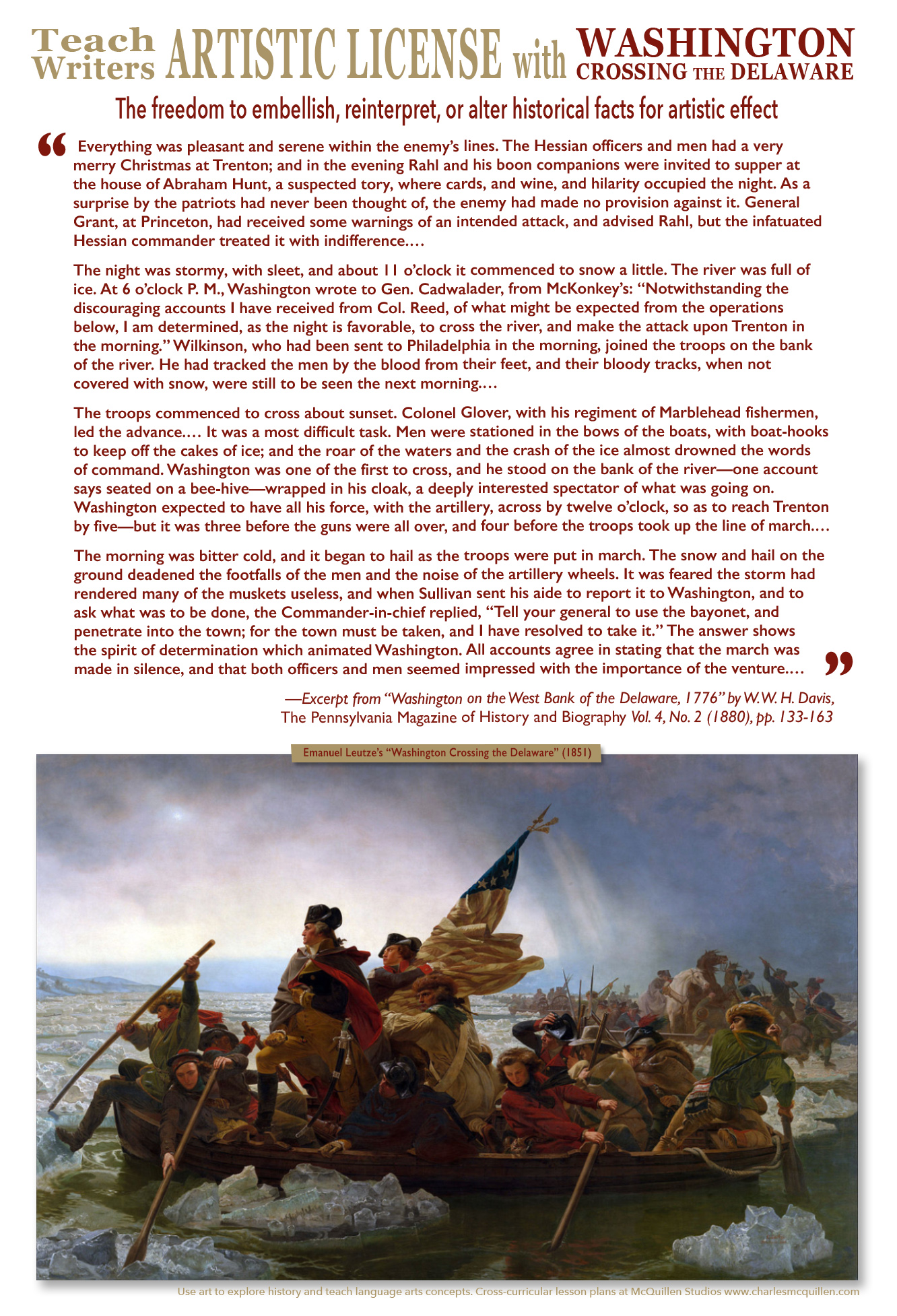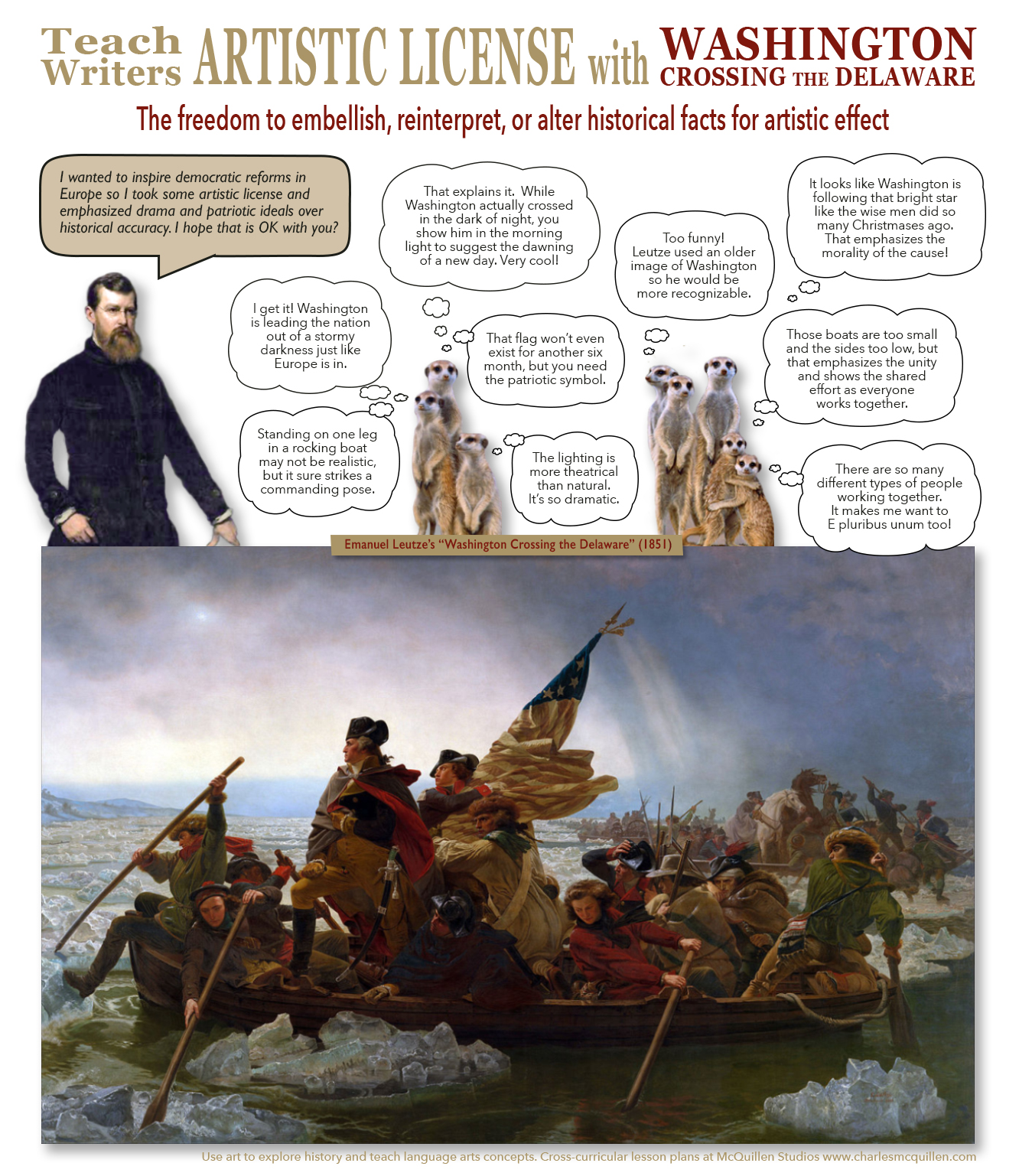Emanuel Leutze’s Washington Crossing the Delaware offers mentor art for teaching students about artistic license.
Mentor texts have long been used to model writing techniques. Mentor art can likewise be used to inspire, teach, and refine student writing. Mentor art has the added benefit of addressing diverse learning styles and providing visual support to language learners. Consider introducing your students to the concept of artistic license with Emanuel Leutze’s Washington Crossing the Delaware.
It is beneficial to let students experience a work of art on its and their own terms before using it as mentor art. This link offers teaching moves and language for introducing students to Emanuel Leutze’s Washington Crossing the Delaware. Access the Metropolitan Museum of Art’s website to learn more about Leutze’s Washington Crossing the Delaware. Project this image for exquisite close-up detail.
 Project the image above, close read the accompanying historical account, and have students respond in small groups to the following discussion prompts and report back. Click on the image to expand. Download the pdf below.
Project the image above, close read the accompanying historical account, and have students respond in small groups to the following discussion prompts and report back. Click on the image to expand. Download the pdf below.
#1 While he was careful to include many historically accurate artifacts, Emanuel Leutze did not let authenticity get in the way of drama. How is the the painting’s depiction of the crossing different than the account in the history journal?
Turn, Talk, and Report Back (Possible answers)
The text says Washington crossed in the darkness of night while the painting shows him crossing at dawn. The text says a sleet and snow storm hampered the crossing while the painting shows the storm had passed. The text says the crossing was difficult as it was buffeted by a storm with ice crashing into the boats yet the painting shows Washington in an improbable pose standing on one leg in the middle of a rocking boat. The text says a regiment of celebrated fishermen led the advance but the painting depicts a range of soldiers from all walks of society. The boat is improbably small for transporting heavy weapons and troops across a rivers swollen with ice.
#2 How do Leutze’s alterations make the scene more dramatic, inspirational, and symbolic?
Turn, Talk, and Report Back (Possible answers)
Washington strikes a confident courageous pose that makes him seem superhuman, immune to the elements and fixated on the mission. To enhance the sense of drama Leutze crammed a diverse group of soldiers onto a boat that was improbably small, the low sides allow the viewer to focus on the soldiers’ expressions and efforts. The boat represents the revolutionary cause and that all Americans are in it together. Everyone is shown working and sacrificing together. The diversity depicts national unity and expresses the United States’ motto E pluribus unum—out of many, one. The lighting is more theatrical than natural. It makes the scene more dramatic. The dawning light silhouettes Washington’s profile which makes him look more heroic. The early morning shadows unify the soldiers on the boat. The breaking dawn is symbolic and suggests Washington is leading the nation out of a stormy darkness and into a new day with a bright future. The morning star that seems to guide Washington is similar to the star of Bethlehem that guided the three wise men at the original Christmas. This reinforces the morality of his cause.
#3 How does Emanuel Leutze’s use of artistic license inform the way you write about events? (Answers will vary though students may note that they will carefully select the details they will share and that they may orchestrate certain details to make their writing more dramatic. You may also want to discuss when artistic license is allowable—fiction writing and personal essays—and when writers must adhere to observable facts—lab reports and nonfiction writing.)
Expand your discussion with Emanuel Leutze and a group of meerkats. Note the meerkats are an unpredictable lot and can be a tad impetuous. Their opinions and actions are not those of this organization. Don’t blame us for what they think. Click on the image to expand. Drag the jpg image into a Word document to create your own handout.
How would you use Emanuel Leutze’s Washington Crossing the Delaware to teach about artistic license or other writing techniques? Extend the discussion with your comments below.
Related Resources
- Emanuel Leutze’s Washington Crossing the Delaware is in the MET’s collection. See their website for detailed information. Select the image to magnify.
- This interdisciplinary teacher’s resource offers a range of teaching moves and language for analyzing Washington Crossing the Delaware.
- This virtual escape room explores Emanuel Leutze’s Washington Crossing the Delaware and how his crew embodies the motto, “E Pluribus Unum”
- This Look and Learn Gallery Walk explores Leutze’s life and the art and events that inspired him to paint Washington Crossing the Delaware. Special attention is given to key historical events from the American Revolution and the first national motto, E Pluribus Unum.
- This team-building game reviews key learnings from Washington Crossing the Delaware gallery walk.
- This sorting activity explores the distinct styles of art of four influential American artists from the mid 1800s — Albert Bierstadt, Eastman Johnson, Emanuel Leutze, and Worthington Whittredge.
Artistic-License-with-MK-Handout


Comments are closed, but trackbacks and pingbacks are open.